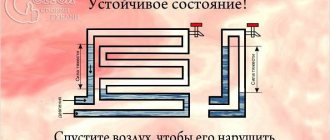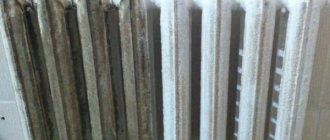Sudden narrowing of the pipeline
If the liquid enters the pipe from a pipe with a larger cross-section, liquid flow conditions occur with a sudden narrowing of the pipeline (Fig. 19).
Rice. 19. Calculation diagram of a sudden narrowing of the pipeline
The magnitude of the head loss for this sudden contraction case can be expressed by the general equation
where and
– fluid velocity in a pipe of smaller diameter.
The resistance coefficient ζ for this case depends on the ratio of the diameters d2 and d1 of pipes of small and large sections (we neglect the influence of the Re number).
For practical calculations, you can use the data below:
| ….. | 4 | 3,5 | 3 | 2,5 | 2,0 | 1,5 | 1,25 | 1,1 | 1,0 |
| ζ…….. | 0,45 | 0,43 | 0,42 | 0,4 | 0,37 | 0,28 | 0,19 | 0,1 |
In the general case, the resistance coefficient for a sudden narrowing of the pipeline is calculated by the expression (in the calculations, the velocity of the liquid in a small cross-section pipe is taken)
where F and f are the cross-sectional area of the pipeline, respectively, before the narrowing and at the narrowing point.
To reduce vortex formation and associated pressure losses that occur during sudden contractions, the transition edge is rounded or chamfered. The maximum effect is achieved with a gradual (conical) narrowing with a smooth coupling of the conical and cylindrical sections. For this, a cone with an angle α = 40 ÷ 60 0 can be recommended. The value of the coefficient ζ in this case can be taken equal to 0.1 – 0.15.
Source
Example of heating system calculation
In most cases, a simplified calculation is performed based on such parameters as the number of rooms, the level of its insulation, the difference in temperature flow and coolant velocity in the inlet and outlet pipelines.
The diameter of the heating pipe with forced circulation is determined in the following sequence:
- the total amount of heat that needs to be supplied to the room is determined (thermal power, kW), it is also possible to rely on tabular data;
- Having set the speed of water movement, the optimal D is determined.
Calculation of thermal power
As an example, a standard room with dimensions of 4.8x5.0x3.0m will be used. The heating circuit is with forced circulation; it is necessary to calculate the diameters of the heating pipes for distribution throughout the apartment. The main calculation formula looks like this:
The following notations are used in the formula:
- V – amount of room. In the example, it is equal to 3.8•4.0•3.0 = 45.6m 3 ;
- ?t is the difference between the temperature outside and inside. In the example, 53?C is assumed;
- K is a special coefficient that determines the degree of insulation of the building. In general, its value ranges from 0.6-0.9 (effective thermal insulation is used, the roof and floor are insulated, at least double-glazed windows are installed) to 3-4 (buildings without thermal insulation, for example, change houses). In the example, an intermediate option is used - the apartment has standard thermal insulation (K = 1.0 - 1.9), K = 1.1 is accepted.
The total thermal power should be equal to 45.6•53•1.1/860 = 3.09 kW.
It is possible to use tabular data.
Diameter determination
The diameter of the heating pipes is determined by the formula
Where notations are used:
- ?t – difference in coolant temperatures in the supply and discharge pipelines . Considering that water is supplied at a temperature of about 90-95?C, and it has time to cool down to 65-70?C, the temperature difference can be taken as equal to 20?C;
- v – speed of water movement . It is undesirable for it to exceed 1.5 m/s, and the minimum acceptable threshold is 0.25 m/s. It is recommended to stay at an intermediate speed value of 0.8 - 1.3 m/s.
Note! An incorrect choice of pipe diameter for heating can lead to a drop in speed below the minimum threshold, which in turn will lead to the formation of air locks. As a result, the work efficiency will become zero.
The value of Din in the example will be v354•(0.86•3.09/20)/1.3 = 36.18 mm. If you pay attention to the standard sizes, for example, of a PP pipeline, you will see that there is no Din. Under such conditions, the closest diameter of propylene pipes for heating is easily selected.
In this example, it is possible to select PN25 with a diameter of 33.2 mm; this will lead to a slight increase in the coolant movement speed, but it will still remain within acceptable limits.
Features of heating systems with natural circulation
Their main difference is that they do not use a circulation pump for pressure. The liquid moves by gravity, upon completion of heating it is forced upward, after which it passes through the radiators, cools and returns to the boiler.
Compared to systems with forced circulation, the diameter of pipes for heating with natural circulation must be larger. The basis of calculation in this case is that the circulation pressure exceeds the losses due to local resistance and friction.
In order not to calculate the value of the circulation pressure every time, there are special tables compiled for various temperature differences. For example, if the length of the pipeline from the boiler to the radiator is 4.0 m, and the temperature difference is 20? C (70? C in the outlet and 90? C in the supply), then the circulation pressure will be 488 Pa. Based on this, the coolant speed is selected using the transformation method D.
When performing calculations yourself, a verification calculation is also necessary. In other words, the calculations are carried out in the reverse order, the purpose of the check is to determine whether the losses due to local resistance and friction do not exceed the circulation pressure.
Why do we need calculations of pipe parameters?
In modern construction, not only steel or galvanized pipes are used. The choice is already quite wide - PVC, polyethylene (HDPE and LDPE), polypropylene, metal-plastic, corrugated stainless steel. They are good because they do not have as much mass as their steel counterparts. However, when transporting polymer products in large volumes, it is advisable to know their weight in order to understand what kind of machine is needed. The weight of metal pipes is even more important - delivery is calculated by tonnage. So it is advisable to control this parameter.
What cannot be measured can be calculated
It is necessary to know the outer surface area of the pipe to purchase paint and thermal insulation materials. Only steel products are painted, because they are susceptible to corrosion, unlike polymer ones. So you have to protect the surface from exposure to aggressive environments. They are used more often for the construction of fences, frames for outbuildings (garages, sheds, gazebos, cabins), so the operating conditions are difficult, protection is necessary, therefore all frames require painting. This is where the area of the surface to be painted is required - the outer area of the pipe.
When constructing a water supply system for a private house or cottage, pipes are laid from the water source (well or borehole) to the house - underground. And still, to keep them from freezing, insulation is required. You can calculate the amount of insulation by knowing the outer surface area of the pipeline. Only in this case it is necessary to take material with a substantial margin - the joints must overlap with a substantial margin.
The cross-section of the pipe is necessary to determine the throughput - whether this product can carry the required amount of liquid or gas. The same parameter is often needed when choosing the diameter of pipes for heating and plumbing, calculating pump performance, etc.
Example of heating system calculation
As a rule, a simplified calculation is performed based on such parameters as the volume of the room, the level of its insulation, the flow rate of the coolant and the temperature difference in the inlet and outlet pipelines.
The diameter of the heating pipe with forced circulation is determined in the following sequence:
- the total amount of heat that needs to be supplied to the room is determined (thermal power, kW), you can also rely on tabular data;
Calculation of thermal power
As an example, a standard room with dimensions of 4.8x5.0x3.0m will be used. The heating circuit is with forced circulation; it is necessary to calculate the diameters of the heating pipes for distribution throughout the apartment. The basic calculation formula looks like this:
The following notations are used in the formula:
- V is the volume of the room. In the example, it is equal to 3.8∙4.0∙3.0 = 45.6m 3 ;
- Δt is the difference between the temperature outside and inside. In the example, 53ᵒС is taken;
- K is a special coefficient that determines the degree of insulation of the building. In general, its value ranges from 0.6-0.9 (effective thermal insulation is used, the floor and roof are insulated, at least double-glazed windows are installed) to 3-4 (buildings without thermal insulation, for example, change houses). In the example, an intermediate option is used - the apartment has standard thermal insulation (K = 1.0 - 1.9), K = 1.1 is accepted.
The total thermal power should be 45.6∙53∙1.1/860 = 3.09 kW.
You can use tabular data.
Diameter determination
The diameter of the heating pipes is determined by the formula
Where notations are used:
- Δt – difference in coolant temperatures in the supply and discharge pipelines . Considering that water is supplied at a temperature of about 90-95ᵒС, and it has time to cool down to 65-70ᵒС, the temperature difference can be taken equal to 20ᵒС;
- v is the speed of water movement . It is undesirable for it to exceed 1.5 m/s, and the minimum acceptable threshold is 0.25 m/s. It is recommended to stay at an intermediate speed value of 0.8 - 1.3 m/s.
Note! An incorrect choice of pipe diameter for heating can lead to a drop in speed below the minimum threshold, which in turn will cause the formation of air locks. As a result, work efficiency will become zero.
The value of Din in the example will be √354∙(0.86∙3.09/20)/1.3 = 36.18 mm. If you pay attention to the standard sizes, for example, of a PP pipeline, you will see that there is simply no such Din. In this case, simply select the closest diameter of propylene pipes for heating.
In this example, you can choose PN25 with a diameter of 33.2 mm, this will lead to a slight increase in the coolant flow rate, but it will still remain within acceptable limits.
Features of heating systems with natural circulation
Their main difference is that they do not use a circulation pump to create pressure. The liquid moves by gravity, after heating it is forced upward, then passes through the radiators, cools and returns to the boiler.
Compared to systems with forced circulation, the diameter of pipes for heating with natural circulation must be larger. The basis of the calculation in this case is that the circulation pressure exceeds friction losses and local resistance.
In order not to calculate the value of the circulation pressure each time, there are special tables compiled for different temperature differences. For example, if the length of the pipeline from the boiler to the radiator is 4.0 m, and the temperature difference is 20°C (70°C in the outlet and 90°C in the supply), then the circulation pressure will be 488 Pa. Based on this, the coolant speed is selected by changing D.
When performing calculations yourself, a verification calculation is also required. That is, the calculations are carried out in the reverse order, the purpose of the check is to determine whether friction losses and local resistance do not exceed the circulation pressure.
Inner and outer diameter, wall thickness, radius
Pipes are a specific product. They have an internal and external diameter, since their wall is thick, its thickness depends on the type of pipe and the material from which it is made. Technical specifications often indicate the outer diameter and wall thickness.
Pipe inner and outer diameter, wall thickness
Having these two values, it is easy to calculate the internal diameter - subtract twice the wall thickness from the external one: d = D - 2*S. If you have an outer diameter of 32 mm, a wall thickness of 3 mm, then the inner diameter will be: 32 mm - 2 * 3 mm = 26 mm.
If, on the contrary, there is an internal diameter and wall thickness, but an external one is needed, we add double the stack thickness to the existing value.
With radii (denoted by the letter R) it is even simpler - this is half the diameter: R = 1/2 D. For example, let’s find the radius of a pipe with a diameter of 32 mm. Just divide 32 by two, we get 16 mm.
Vernier caliper measurements are more accurate
What to do if there are no technical data for the pipe? To measure. If special accuracy is not needed, a regular ruler will do; for more accurate measurements, it is better to use a caliper.
Calculation of pipe surface area
The pipe is a very long cylinder, and the surface area of the pipe is calculated as the area of the cylinder. For calculations, you will need a radius (internal or external - depends on what kind of surface you need to calculate) and the length of the segment that you need.
Formula for calculating the side surface of a pipe
To find the lateral area of the cylinder, we multiply the radius and length, multiply the resulting value by two, and then by the number “Pi”, we obtain the desired value. If desired, you can calculate the surface of one meter, which can then be multiplied by the desired length.
For example, let's calculate the outer surface of a piece of pipe 5 meters long, with a diameter of 12 cm. First, let's calculate the diameter: divide the diameter by 2, we get 6 cm. Now all values must be reduced to the same units of measurement. Since the area is calculated in square meters, we convert centimeters to meters. 6 cm = 0.06 m. Next, we substitute everything into the formula: S = 2 * 3.14 * 0.06 * 5 = 1.884 m2. If you round it up, you get 1.9 m2.
Weight calculation
When calculating the weight of a pipe, everything is simple: you need to know how much a linear meter weighs, then multiply this value by the length in meters. The weight of round steel pipes is in reference books, since this type of rolled metal is standardized. The weight of one linear meter depends on the diameter and wall thickness. One point: the standard weight is given for steel with a density of 7.85 g/cm2 - this is the type recommended by GOST.
Round Steel Pipe Weight Table
In table D - outer diameter, nominal diameter - inner diameter, And one more important point: the weight of ordinary rolled steel is indicated; galvanized steel is 3% heavier.
Weight table for profiled square pipe
How to calculate cross-sectional area
Formula for finding the cross-sectional area of a round pipe
If the pipe is round, the cross-sectional area should be calculated using the formula for the area of a circle: S = π*R 2 . Where R is the radius (internal), π is 3.14. In total, you need to square the radius and multiply it by 3.14.
For example, the cross-sectional area of a pipe with a diameter of 90 mm. We find the radius - 90 mm / 2 = 45 mm. In centimeters this is 4.5 cm. We square it: 4.5 * 4.5 = 2.025 cm 2, substitute it into the formula S = 2 * 20.25 cm 2 = 40.5 cm 2.
The cross-sectional area of a profiled pipe is calculated using the formula for the area of a rectangle: S = a * b, where a and b are the lengths of the sides of the rectangle. If we consider the cross-section of the profile to be 40 x 50 mm, we get S = 40 mm * 50 mm = 2000 mm 2 or 20 cm 2 or 0.002 m 2.
What does narrowing the diameter of the pipeline lead to?
Consequences of narrowing the pipeline diameter:
- The pressure loss increases - according to the laws of hydrodynamics (along with turns, corners, tees). Therefore, when designing, an allowance for pipe narrowing is always taken into account.
- The formation of “blind spots”, vortices, which further narrow the cross-section of the pipeline.
- The larger the internal diameter of the pipe, the less pressure occurs in the system and vice versa. Thus, at the point of narrowing, the pressure increases sharply due to the need to pass the same volume through a smaller cross-sectional area of the pipe.
- The equivalent length increases, which is important when calculating the parameters of circulation or feed pumps.
- Cavitation noise may occur at the narrowing site.
- The speed of movement of the coolant or supplied liquid slows down.
The best option for installing a heating system is to use one standard size for the main line, and make branches from it smaller in diameter. This will make the coolant circulation more controlled and simplify calculations.
How to calculate the volume of water in a pipeline
When organizing a heating system, you may need a parameter such as the volume of water that will fit in the pipe. This is necessary when calculating the amount of coolant in the system. For this case, we need a formula for the volume of a cylinder.
Formula for calculating the volume of water in a pipe
There are two ways: first calculate the cross-sectional area (described above) and multiply it by the length of the pipeline. If we calculate everything according to the formula, we will need the internal radius and the total length of the pipeline. Let's calculate how much water will fit in a system of 32 mm pipes 30 meters long.
First, let's convert millimeters to meters: 32 mm = 0.032 m, find the radius (divide in half) - 0.016 m. Substitute into the formula V = 3.14 * 0.016 2 * 30 m = 0.0241 m 3. It turned out = a little more than two hundredths of a cubic meter. But we are used to measuring the volume of the system in liters. To convert cubic meters into liters, you need to multiply the resulting figure by 1000. It turns out 24.1 liters.
Source
The influence of pipe diameter on efficiency for a heating system in a private house
It is a mistake to rely on the “bigger is better” principle when choosing a pipeline cross-section. Too large a pipe cross-section leads to a decrease in pressure in it, and hence the speed of the coolant and heat flow.
Moreover, if the diameter is too large, the pump simply may not have enough performance to move such a large volume of coolant.
Important! A larger volume of coolant in the system implies a high total heat capacity, which means more time and energy will be spent on heating it, which also affects the efficiency in a negative way.
Selection of pipe section: table
The optimal pipe cross-section should be the smallest possible for a given configuration (see table) for the following reasons:
- a small volume of coolant heats up faster;
- smaller clearance creates greater resistance to the movement of the coolant , it slows down, which leads to a decrease in noise;
- a small diameter pipeline will fit better into the interior and will cause fewer difficulties during installation;
- Its cost depends on the size of the pipe , so thin pipes are more affordable.
However, you should not overdo it: in addition to the fact that the small diameter creates an increased load on the connecting and shut-off valves , it is also not able to transfer enough thermal energy.
To determine the optimal pipe cross-section, use the following table.
Photo 1. Table showing the values for a standard two-pipe heating system.
Types of rolling and bending
Using rolling, you can make a product of the required shape from tubes. Moreover, using this method you can not only bend a product made of any metal, but also reduce the diameter.
The diameter of the pipe can be reduced using special equipment
Bending and changing the shape of a pipe is called rolling. This process received this name because the tool used for this is rollers.
Rolling is used for different purposes:
- To reduce the diameter of tubes made of different materials. This way you can deform thin-walled products made of stainless steel, cast iron, steel, etc.
- Using rolling, you can bend the product. In this case, you need to bend according to a special template.
- Extension and straightening. However, this is not recommended, as the product loses strength.
- Increase in diameter. However, this process is considered the most labor-intensive.
- Using a special pipe bender, you can bend the product into a coil with your own hands.
All the processes described are used in the manufacture and repair of tubular products. With their help, you can even make elements bent into a ring to decorate forged gates.
Pipe diameter selection parameters
First of all, you need to take into account that the rules for choosing pipes for different heating schemes are significantly different.
If the heating system is connected to a central heating main, then the pipe diameter is calculated similarly to apartment heating systems .
If autonomous heating is planned, then the diameter here may be different depending on whether the system will operate using a circulation pump or through natural circulation.
The choice is influenced by:
- Pipe material
- Coolant type
- heating system wiring
- Estimated water pressure
- Water flow rate
When calculating the diameter of the pipeline, you should initially take into account what type of pipes will be used for installation. This is necessary because the system for measuring and marking pipes differs based on the material from which it is made. As a rule, steel and cast iron pipes are marked based on the internal diameter, and plastic and copper pipes based on the outer section. This is a particularly important factor if you plan to install a pipeline using a combination of several materials.
Ideally, you should entrust the calculation procedure to a specialist, however, if you do not have such an opportunity or simply have the desire, then you can completely handle it yourself.
How to reduce the diameter of a pipe?
Vladimir VV:
In terms of work 5 and in terms of functionality 1. Firstly. There is an ordinary transitional threaded cast iron tee. Secondly. With this connection, the pipe should enter the body no more than the thickness of the wall
Hardzei Bumanite:
Mark missed a letter in the title
Computer this you can:
This is done simply! Place the cutter with the opposite end and heat it using the friction method, you get the same result. But without autogen
qlmanlp:
SA will give a like for the lathe.
serguda111:
all this can be done much easier with the help of a simple cutter clamped with the back side and no burners are needed; the workpiece heats up from friction
Victor Dovgopolyuk:
I flared the 40th pipe on a cold lathe with a rotating center offset on the transverse slide of the tailstock, only from the inside to the outside
TechDoor:
Thought, however










